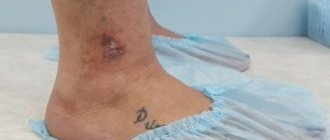Last update: 03/03/2021
The neck is one of the most sensitive areas of our body; the skin in this area is extremely susceptible to external influences, including those of an allergic nature. The appearance of allergies in the neck can cause unpleasant physical sensations and interfere with putting on clothes or taking a shower; In addition, psychological inconveniences associated with the manifestations of allergic reactions on open areas of the skin cannot be ruled out. This is why it is so important to know about the causes, symptoms and treatments for this disease.
Causes of neck allergies
Neck allergies can be caused by local exposure, or may be part of a systemic reaction to a particular allergen. Among the local causes that most often cause allergy symptoms on the skin of the neck are:
- Prolonged exposure to sweat (heat rash);
- Exposure to metal objects. Chains, necklaces, clasps and other items made of simple or precious metals may cause allergies when in prolonged contact with the skin;
- Cosmetics;
- External medications;
- Ultraviolet (usually in combination with other factors, for example chemicals).
In addition, neck allergies may be part of a systemic response to food allergens (fish, citrus fruits, berries, etc.), environmental factors (dust, pollen, microorganisms, wool), etc.
Causes of the rash
Skin rashes can be caused by a number of different reasons: infections, allergic reactions, autoimmune diseases, exposure to heat, sunlight.
Causes of the rash include:
- atopic dermatitis (eczema);
- contact dermatitis;
- urticaria (caused by an allergic reaction to food or medication, infection, stress, contact with animals, chemicals, exposure to sunlight, cold, etc.);
- infectious diseases of viral, bacterial, fungal nature (measles, rubella, chickenpox, scarlet fever, hand-foot-mouth syndrome, molluscum contagiosum, lichen rosea, ringworm, seborrheic dermatitis, erythema infectiosum, herpes zoster, bacterial tonsillopharyngitis, impetigo, multisystem inflammatory syndrome in children associated with COVID-19);
- acarodermatitis (parasitic disease, scabies);
- rosacea;
- lichen planus;
- autoimmune diseases (psoriasis, systemic lupus erythematosus, dermatomyositis);
- malignant diseases of the mammary glands in women (inflammatory breast cancer, Paget's cancer, etc.);
- acne;
- acne of newborns (neonatal pustulosis);
- toxic erythema of newborns;
- diaper dermatitis;
- prickly heat;
- insect bites;
- taking medications (allergy to amoxicillin, Stevens-Johnson syndrome, erythema multiforme exudative);
- angioedema (Quincke's edema).
Allergy treatment
The basic principle of treating any allergic reaction is to eliminate the causes that caused it. In addition, patients are often prescribed a special elimination diet to protect themselves from food allergens. In the treatment of allergies, anti-allergic and anti-inflammatory drugs of local and systemic action are also used.
Of great importance in the treatment of allergic reactions is the elimination of the most unpleasant symptoms: redness, burning, itching. La-Cri products, compatible with modern anti-allergy drugs, can help with this:
- La-Cri cream reduces burning and itching, helps reduce erythema (redness);
- Emulsion "La-Cri"
allows you to make the skin less sensitive, get rid of flaking and dryness; - Cleansing gel "La-Cri"
allows you to cleanse the skin of irritants and allergens.
When should you see a doctor if a rash occurs?
Often the rash does not require treatment and goes away on its own; in other cases, treatment consists of taking antihistamines and using topical medications that reduce itching and swelling, topical corticosteroids.
The rash may be a symptom of an underlying disease or indicate the development of an allergic reaction.
You should not engage in self-diagnosis or self-medication; to find out the cause of the rash, diagnosis and proper treatment, you must consult a doctor.
Rashes in infants are often not truly allergic. Read more about tactics for prickly heat, newborn acne, diaper dermatitis and other types of rashes in the material “Rashes in Babies.”
You should contact a pediatrician if air baths, prevention of overheating, frequent diaper changes, and the use of local remedies do not give a positive result, the rash does not go away within a few days; you notice signs of infection - increasing pain, swelling, redness of the skin, rashes accompanied by the release of pus, the formation of crusts, enlarged lymph nodes in the armpits, neck or groin; the child is lethargic, refuses to eat, and has a fever.
Get emergency medical help if the rash appears suddenly, spreads quickly throughout the body, is accompanied by severe itching, blistering, fever, swelling of the lips, eyelids, cheeks, hands, neck, vomiting, difficulty breathing, difficulty swallowing, or changes in skin color .
Experts' opinion
The conducted clinical study proves the high efficiency, safety and tolerability of products for daily skin care of children and adults with mild and moderate forms of atopic dermatitis and during remission, accompanied by a decrease in the quality of life of patients. As a result of therapy, a decrease in the activity of the inflammatory process, a decrease in dryness, itching and flaking was noted.
Based on the results of joint research, the following information is placed on product packaging: “Recommended by the St. Petersburg branch of the Union of Pediatricians of Russia.”
Sources:
- Yukhtina N.V., Modern ideas about atopic dermatitis in children
- Kamasheva G.R., Khakimova R.F. Valiullina S.A., Methods for assessing the severity of atopic dermatitis in young children, Dermatology journal, 2010
- G.V. Molokova, E.V. Bukina, Diaper dermatitis in children with sensitive skin, Journal of Dermatology and Allergology, 2019
- N.L. Rybkina, Modern approaches to newborn skin care: pediatrician tactics, journal Bulletin of Modern Clinical Medicine, 2014
Ointments and creams for dermatitis
Creams or ointments for dermatitis have slightly different compositions. Thus, the ointment is made on a fat basis, which can be used as vegetable or mineral oils or animal fats. Such products have a dense, slightly viscous structure. They are not immediately absorbed into the skin, but penetrate into its deeper layers. Ointments are not recommended for treating wet surfaces. They are much more effective against dry rashes and chronic inflammation.
Creams have a different base - hydrophilic. Thanks to this, they have a lighter structure, are well absorbed and do not leave greasy marks on the skin. The creams are suitable for the treatment of moderately weeping rashes; they are used for acute inflammation, for lesions of the facial skin and areas with a large number of sebaceous glands, where the use of oily products is undesirable.
Let's consider several options for dermatitis remedies used in medical practice:
- hormonal ointments with pronounced antiallergic and anti-inflammatory effects, which include topical corticosteroids;
- non-hormonal topical agents that have anti-inflammatory and antibacterial effects, relieve itching and promote wound healing.
Non-hormonal drugs
Non-hormonal creams do not contain corticosteroids. The composition may be based primarily on plant components, or not contain them at all. These medications do not act quickly. Their main advantage is the possibility of using them for a long time, including in children. Among non-hormonal creams and ointments there are products with antiseptic, anti-inflammatory, moisturizing, and regenerating effects.
Hormonal drugs
Hormonal ointments and creams in the treatment of dermatitis are considered more effective than non-hormonal ones. The drugs can contain either one active component (topical glucocorticosteroid) or have a complex effect due to the presence of an antibiotic and an antifungal agent in the composition. The use of combined drugs is advisable in case of a complicated course of the disease, when a secondary bacterial or fungal infection is added to the inflammation.
Treatment of atopic dermatitis
To achieve maximum effectiveness from therapy, it is recommended to follow an integrated approach:
- identify and, if possible, eliminate the factors causing atopic dermatitis;
- drug therapy with local agents, selected depending on the severity and form of inflammation;
- proper skin care using moisturizers and softening agents (emollients).[4]
Akriderm preparations are products for the local treatment of manifestations of atopic dermatitis with a wide spectrum of action, produced in the form of cream and ointment of 15 g and 30 g. Depending on the severity, localization, form and course of the disease, the drug is selected:
- with one active ingredient – Akriderm® ointment and cream;
- combined preparations “hormone + antibiotic” - ointments and creams Akriderm GENTA;
- combined preparations “hormone + antibiotic + antimicrobial component” - ointments and creams Akriderm GK.
The modern drug Akriderm GK is a potent drug[5] and has 4 effects at once:
- anti-inflammatory;
- antiallergic;
- antibacterial;
- antifungal. [6]
Treatment of seborrheic dermatitis
The cause of seborrheic dermatitis is infection of the skin by the yeast-like fungus Malassezia. For its treatment, external antimycotics or antifungal drugs are prescribed. Akriderm SK ointment contains betamethasone and salicylic acid. The drug has anti-inflammatory, anti-allergic, anti-exudative, anti-edematous and antipruritic effects, inhibits the accumulation of leukocytes, inhibits phagocytosis, reduces vascular tissue permeability, and prevents the formation of inflammatory edema. As a result of use, the microflora of the skin is restored, scales are exfoliated and sebum production is normalized.[7]
Treatment of allergic dermatitis
To successfully treat allergic dermatitis, it is first necessary to determine the allergen that provoked the disease and partially or even completely eliminate the provoking substance. In the acute period, a specialist may prescribe the use of compresses with cold water and tanning decoctions, which are applied every 3-4 hours for 15 minutes. This helps reduce skin weeping. Drug treatment involves the use of topical glucocorticosteroids in the form of ointments and creams, which are selected depending on the form and severity of inflammation.[8]
If allergic dermatitis is complicated by a microbial infection, it is recommended to use combined external medications, such as Akriderm GK, which, in addition to GCS, contain an antibiotic (gentamicin) and an antifungal component (clotrimazole).
Remember that treatment of dermatitis and selection of medications is carried out only by a specialist dermatologist after a preliminary consultation and examination of the patient.
Brief characteristics of the most common types of skin allergies
Hives
The term “urticaria” unites a whole group of diseases of different nature, but with a similar clinical symptom - blistering-type skin rashes, reminiscent of a nettle burn.
The causes of urticaria are varied. Skin allergies can develop as a result of a reaction to allergens (eg, food, insect bites, medications) or from physical causes such as exposure to the sun, cold, heat and pressure. Hives can be triggered by concomitant diseases of the gastrointestinal tract, endocrine system, or chronic infection.
A typical symptom of urticaria is the appearance of rashes on the skin accompanied by itching. The skin around them may be red. Sometimes all the elements on the affected area of the skin can merge together, forming giant blisters.
The main characteristic of skin allergies is the complete reversibility of blisters: after some time they disappear without a trace, leaving no traces, white spots or scars. But unlike a regular nettle burn, this disease appears again, and with a change in location: today the urticaria was on the legs, and tomorrow it can be found on the arms.
Allergic contact dermatitis
Allergic contact dermatitis is a skin allergy caused by direct exposure to an irritating substance, or allergen.
Most often, contact dermatitis is caused by household chemicals, cosmetics, various chemicals, nickel, latex, and some medications.
Allergic contact dermatitis develops on areas of the skin that have been or are in contact with an allergen.
The first symptoms and signs of contact dermatitis may not develop immediately, but some time after contact with the allergen - several hours, days or even weeks.
The main manifestations of allergic contact dermatitis: redness and swelling of a limited area of the skin that has been in contact with the allergen, severe itching in the area of redness, and the appearance of blisters of various sizes on the skin with a clear liquid inside. When damaged, the bubble bursts and erosion forms in its place. When the skin allergy subsides, yellow crusts remain for some time.
Atopic dermatitis
Atopic dermatitis is a chronic allergic skin disease accompanied by itching and rash. This skin allergy is common in infants and children and usually begins in the first 6 months of life, often continuing into adulthood.
Atopic dermatitis is a multifactorial disease. The leading factor is hereditary predisposition. Food and inhalant allergens play an important role. In childhood, the main food allergens are milk proteins, chicken eggs, fish, and grains. With age, inhalation allergens are added: house dust, animal hair, plant pollen.
Provoking factors for atopic dermatitis can be mechanical, physical or chemical irritants, increased sweating, tobacco smoke, stress, hormonal factors, and infection.
Atopic dermatitis has three sequential forms (infantile, childhood and adult dermatitis), differing in the characteristics of their manifestation.
Any form of atopic dermatitis is characterized by dry skin, itching, thickening of the skin with increased skin pattern, peeling, redness and rashes.
With atopic dermatitis, a vicious circle is formed: itching - scratching - rash - itching. The skin with atopic dermatitis is changed even without an exacerbation. Its structure and water balance are disturbed.
Eczema
Eczema is a chronic recurrent skin disease of allergic origin, characterized by a polymorphic itchy rash (vesicles, erythema, papules). The causes of eczema can be very different, from external factors (chemicals, drugs, food and bacterial allergens) to internal ones.
Exacerbations of this type of skin allergy occur under the influence of psycho-emotional stress, diet disorders, contact with chemicals and other allergens.
Depending on the cause of the appearance and location of the rash, several types of eczema are distinguished: seborrheic, true, occupational, microbial. The areas where the rash is localized tend to itch and peel, causing a lot of inconvenience to the person. Eczema is chronic with periods of exacerbations and remissions, and treatment of skin allergies is often complicated by the addition of pyoderma or herpes. With skin allergies of this type, changes in the functional activity of the digestive tract, metabolic processes, neuroendocrine disorders, and vegetative-vascular dystonia can also be observed.
Toxidermy
Toxidermia is an acute toxic-allergic inflammatory skin lesion, which is an allergic reaction to the introduction into the body (inhalation, ingestion, parenteral administration) of substances with allergenic properties.
The causes of toxicerma are most often drugs and food products.
More often, widespread toxicerma is observed, which is manifested by multiple rashes and itching. Often this type of skin allergy involves the mucous membranes, which may also have various rashes.
In addition to the common one, fixed toxicoderma is possible, in which one or more swollen red spots of round or oval shape appear; in some cases, a bubble may form in the center of each of them. Typically, such skin allergies are associated with taking medications. After the action of the allergen ceases, the inflammatory phenomena subside, and the stain remains for a long time. The most severe forms of toxicerma are Stevens-Johnson syndrome and Lyell's syndrome. They are considered emergencies and require hospitalization.
With a huge variety of allergic dermatoses themselves, there are diseases with similar symptoms. For example, a rash can accompany some infections, diseases of internal organs, etc. Therefore, do not try to diagnose yourself with “skin allergies” and do not self-medicate.
Only a doctor, having collected a detailed history and conducted the necessary examination, will be able to determine the exact cause of the disease and prescribe medications that are suitable in each specific case.








